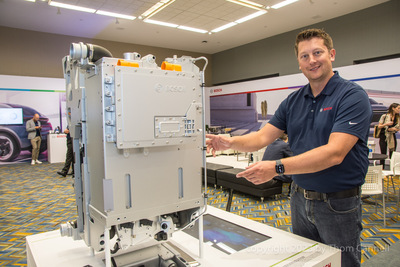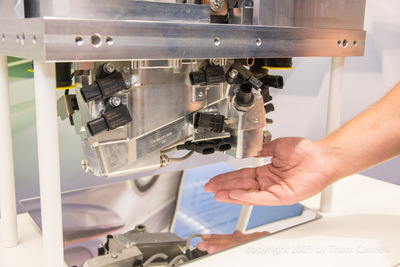Bosch Fuel cells and hydrogen, here and now.
By Thom Cannell
Senior Editor
Technology and Big Rigs
Michigan Bureau
The Auto Channel
In 2022 I finally touched a production hydrogen fuel cell. You know, “The Power Source of The Future, The Future of Trucking, The Solution to the Ills Of Mankind. Hydrogen is real, here, available, relevant and accessible in 2023.
The first fuel cells were invented by Sir William Grove in 1838, according to Wikipedia, and since then hydrogen technology has always been “10 years from now.” Why now, why all the buzz? Primary stimulants are energy use in Europe and the global drive to decarbonization.
In its North American International Auto Show booth, Bosch presented a working fuel cell and we began our journey down the hydrogen-fueled rabbit hole.
Things to know about fuel cells:
- Fuel cells are perfect for Class 8 long-haul and inter-modal trucks—that’s where the first volume application will be seen.
- North America lags behind hydrogen fueling stations badly; there’s only real available hydrogen fuel in California.
- The United States will require approximately 840 hydrogen fuel stations to make it all work (more on that, also later.)
- The Inflation Reduction Act significantly boosted fuel cells and battery production.
- Fuel Cell vehicles require, typically, a high-powered battery, whether lithium-ion (LMC), lithium-iron-phosphate (LFP) or other type to balance loads.
- Nikola uses Bosch fuel cells and Bosch has other, unannounced partners.
- Bosch is open a facility in Anderson, South Carolina to make fuel cells, a $200 million dollar investment.
- Toyota is about to drop its third-generation all-new fuel cell.
- Bosch isn’t alone, Ballard is in production and has longstanding relationship with Ford Motor Company, plus General Motors, Hyundai and Toyota, among others.
- Ballard is making fuel cells for the German truck company Quantron (which we will detail in another story.)
Bosch surely did not invest millions for one customer, rather basing the facility on “a certain volume.” Bosch fuel cell systems engineer Matt Thorington said “We make sure we have enough volume in the market to support our investment, and this is the product that we'll be making in Anderson. Due to size and weight, to ship (fuel cells) internationally is very difficult (and costly), so on the logistics side, (Anderson) makes sense.”
"Hydrogen is like a Swiss Army knife," explained Matt. “It can be used as a fuel, as a store of energy, or as a replacement ingredient to make industries cleaner. The only emission from the fuel cells is water. And the only emission from electrolysis— how green hydrogen is produced—is oxygen.”
A fuel cell stack is like a stack of playing cards, but those “cards” include permeable membranes to permit electrons to move through. Hydrogen and atmospheric air go in one side, power and water vapor comes out the other side. Basically, “there's one membrane and two bipolar plates. We call that a cell, but each can generate less than one volt of electrical power. So, we stacking those together and we're looking at over 300 in this stack.” Thus, stacked in series and making 400 volts DC, “we're talking about 130 kilowatts of electrical power out of a relatively small package.” Every fuel cell vehicle still uses the same type of powertrain as a battery electric truck with a modest battery, fuel cell and electric motor(s) to drive the wheels. However, compared to a BEV, battery electric vehicle, “the battery is much smaller. And that's where the fuel cell has the advantage in terms of weight and size,” Matt said.
Why the battery, if the fuel cell can produce a steady 130 kW—or more? The battery is a buffer, responding quickly to an uphill or need for acceleration, “So I would say as you start to accelerate, the battery is going provide power, but once you're at speed, even if you're on grade, the fuel cell can provide enough power,” in other words, acting like a temporary downshift.
Matt says Bosch has “all the component knowledge, the control systems, and we have the system knowledge to bring all that together. And that's what we're also showing, our control system—which is similar to an ECU or engine control unit.”
There is far more to come; The Auto Channel will have more information on hydrogen production—electrolyzers—what it takes to be energy intensive with hydrogen, and when we can expect to see more trucks and infrastructure globally and in North America.
Hydrogen Powered Vehicles






